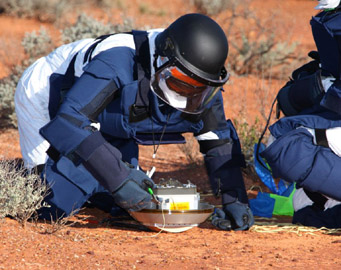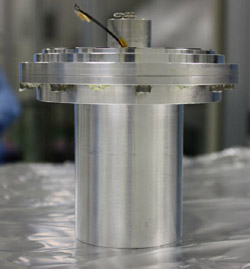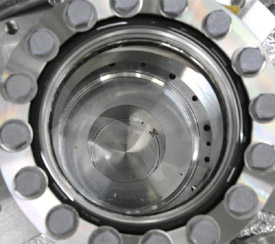Like an expectant father pacing outside the delivery room, I am waiting for word about what Hayabusa has brought home to Earth.

Japanese technicians inspect the Hayabusa sample capsule the day after it landed in Australia on June 13, 2010.
JAXA
Three weeks ago the small, saucer-shaped capsule blazed an incandescent trail across the Australian night sky before parachuting safely onto the ground. When a recovery team plucked it from the remote Woomera Prohibited Area the next morning, the capsule looked shiny-new, none the worse for wear after a seven-year journey to asteroid 25143 Itokawa and back. I was there to welcome it home, as part of a NASA-sponsored effort to record the reentry.
The Japan Aerospace Exploration Agency's recovery team whisked the 16-inch-wide (40-cm) capsule to its Sagamihara research facility, where two dozen scientists are hoping to find bits of asteroidal grit inside. It's being stored — and will be opened — inside an incredibly complex stainless-steel container specially designed for the task. The interior is sometimes kept under a vacuum or flooded with very clean nitrogen.

The small sample-return container from the Hayabusa spacecraft.
JAXA
Then, and now, the question on the minds of all involved has been: What's inside?
Pulses raced today when JAXA announced that scientists have found small particles inside the container. "We are still unsure if those particles are something from [Itokawa] or from the Earth," the brief statement reported.
This is all very curious, because a scan of the capsule revealed that it picked up no particles larger than 1 mm when the spacecraft briefly alighted on Itokawa in November 2005.
So we still don't know whether the spacecraft successfully returned the first-ever sample after landing on an asteroid. (Of course, all of the 22,000 confirmed meteorites found to date are from asteroids — but with very few exceptions, such as Almahata Sitta, we don't know their exact sources.)

Small particles have been found inside Hayabusa's sample container — but are they from asteroid itokawa or Australia? Click here for a larger view.
JAXA
Michael Zolensky, a meteorite specialist from NASA's Johnson Space Center, is one of three Americans participating in the delicate work. "Everyone is going very slowly and carefully," he observes. "It will probably take 30 to 90 days before we know if there is asteroidal sample inside the canister, because we have to eliminate any possibility of contamination first."
I think Zolensky is just being cautious. After all, you'd think that JAXA engineers would have designed the capsule so that Australian dirt couldn't make its way inside when it parachuted to the ground. If those particles aren't from Itokawa, I'd be really surprised.
And so the wait continues.
 7
7
Comments
Martin
July 6, 2010 at 7:28 am
How is it that earth contamination is an issue. Was not the capsule clean and hermetically sealed until its encounter with the asteroid?
You must be logged in to post a comment.
Bruce_in_MN
July 6, 2010 at 7:54 am
It will be rather anticlimactic (and embarrassing) if JAXA has to announce that the sample capsule is empty. This is beginning to sound like another example of a hardware and software system getting so complex that the designers lost sight of the basic goal of the mission. The sampling process should have been highly reliable, simple and robust. Apparently it was not.
You must be logged in to post a comment.
KoC
July 6, 2010 at 10:54 am
Martin - the capsule may be sealed but the outside is probably covered with dust and such from the landing. There's no shame in being careful, especially after all they've gone through to get it back to Earth.
Bruce - are you kidding? You are already starting the armchair quarterbacking before they've even opened the capsule??! Give us a break!
You must be logged in to post a comment.
John Barrett
July 6, 2010 at 6:28 pm
I'm fascinated that Japan took the time, money, and chance to go what they did-why couldn't we americans do that? (I did that with a small "a".)-Looks like we took the back seat again. Wake up America!! this is strike 2!. Betcha they find on those pieces what is here on earth. Let the imagination go wild.
You must be logged in to post a comment.
Scott C. Schumacher
July 7, 2010 at 2:03 pm
I believe it's been reported by JAXA that the propellant charge that was supposed to spall samples of Itokawa into the sample return capsule failed to discharge. I suspect the samples inside are likely particles flayed from the surface of the asteroid by the craft's engine.
Itokawa appears to have no craters, indicating that it has not been impacted within the past 1 - 10 My. That it is a rubble-pile sort of asteroid indicates that it was likely once part of a much larger body, though I've not seen any speculation as to exactly what body. The fact that it has no craters would seem to indicate that the event which caused it to become fragmented from the parent body was relatively recent, perhaps within the past 50 My. On the other hand, one would also surmise that were this true then it would quickly become apparent that Itokawa would be part of some asteroid family, but again I have seen no news that this might be so.
Perhaps inspection of the fragments in the sample capsule my bring revelation as to what is Itokawa's parent body.
You must be logged in to post a comment.
Adolf Schaller
July 9, 2010 at 5:16 pm
It's speculation at this point to be sure, but I think the particles found within the container can't be anything other than material from Itokawa.
Where else can that stuff have come from? I can't imagine that JAXA prepared a container that was either contaminated before it left, or became contaminated after nominally parachuting to the ground.
Judging from the image of the interior of the container, it looks as if they would be readily visible to the eye.
When Hayabusa "alighted" on the surface of Itokawa, it would have supplied plenty of energy to kick particles, however gently, all the way up into the container in that low-gravity before the container was commanded to close.
Scott C. Schumacher makes another valid point with regard to potential thruster activity, but I can't see particles reaching up into the throat of that channel into the canister from thrusters spraying stuff much more violently outwards and away from the spacecraft.
I think all it took was a gentle bounce on the surface to 'splash' some particles upward into that channel leading to the canister. SOME of them would have made it and stayed there, and I think that's what they've got there.
That receptacle was open for quite some time. The key for passive sample-retrieval in this case is entirely due to the very low gravity environment. A gentle bounce or two would have been sufficient to splash some particles up that channel. Hayubasa may even have messed around on the surface and stirred up quite a 'cloud' of particles, and THAT may conceivably have contributed to its problems from that moment onward.
The fact that an x-ray examination before opening which reportedly didn't reveal any particles larger than a millimeter only suggests that an x-ray examination isn't very good at spotting particles larger than about a millimeter within a metal canister. Yet when they opened it up they could SEE stuff in there.
100-to-1 those bits are from Itokawa. Any takers?
You must be logged in to post a comment.
BSJ
July 9, 2010 at 6:13 pm
Why all the protective body amour? Is it because they're in the "restricted zone" with UXO all over the place?
You must be logged in to post a comment.
You must be logged in to post a comment.